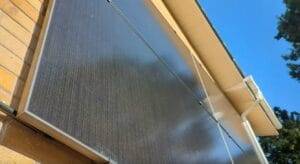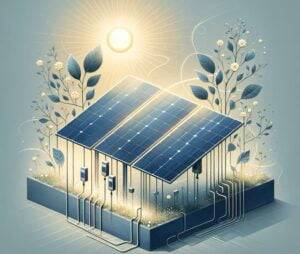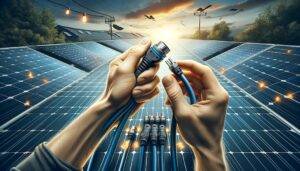You’ve decided to go solar. You understand panels generate energy from sunlight—but what about the mysterious ‘inverter’? Most homeowners don’t realise it’s actually the brain of your solar system, and choosing the wrong one can mean higher bills and wasted savings.
The solar inverter is the conductor of your solar energy system, orchestrating the flow and conversion of energy between your solar panels, batteries, home appliances, and the grid. Think of it as the translator that makes solar energy work with your home’s electrical system.
In This Article:
What is a Solar Inverter?
Typically, a solar inverter is connected to your home, the solar panels and the grid. This is called a grid-tied system. The inverter’s job is to convert Direct Current (DC) from solar panels or battery storage into Alternating Current (AC) for domestic appliances and lighting. The inverter includes intelligent systems for optimising AC production and distributing energy between your panels, battery storage, the grid, and home.
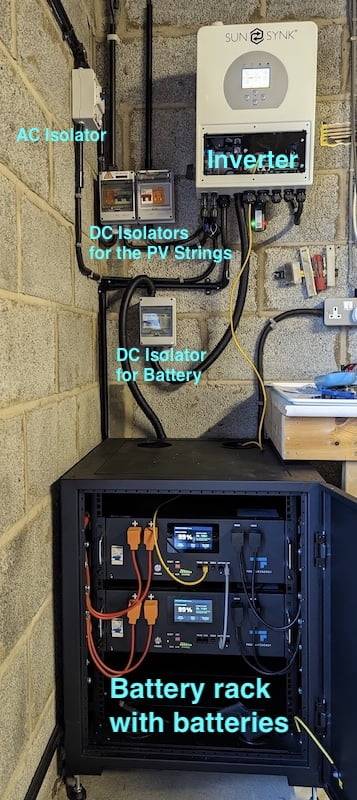
Types of Solar Inverters: UK 2025 Guide
Not all inverters are created equal. The type you choose depends on your roof, budget, and future plans. Here’s what you need to know:
| Inverter Type | Typical Cost (UK 2025) | Efficiency | Shading Performance | Battery Ready? | Best For |
|---|---|---|---|---|---|
| String | £500–£1,000 | High | Poor (weakest panel drags down all) | No | Large, unshaded south-facing roofs |
| Microinverter | £120–£180/panel | Very High | Excellent (each panel independent) | Yes | Complex/shaded roofs, smaller systems |
| Optimizer + String | £1,000–£2,000 | Very High | Very Good | Some models | Medium to large roofs with some shading |
| Hybrid | £1,200–£2,500+ | High | Good | Yes (built-in) | Homes planning battery storage |
Real-World Example: My Hybrid Setup
In my own home, I run two solar arrays at different angles—28° and 6°—with a hybrid Sunsynk 3.6 ECCO inverter and Fogstar batteries. The hybrid setup means I can store energy for evenings and shift usage to cheaper night-time tariffs. If I’d chosen a standard string inverter, I’d be missing out on that flexibility.
The hybrid inverter handles everything: converting solar DC to AC for my home, charging the battery when there’s excess solar, and even buying cheap overnight electricity to store for peak times. It’s like having a smart energy manager that never sleeps.
Why do We Need an Inverter?
Think of electricity like water flowing through pipes. Solar panels produce electricity like a river flowing one way (DC – Direct Current), but your home needs electricity that flows back and forth like waves (AC – Alternating Current). The inverter is the translator that makes them work together.
Converts DC From Solar Panels and Batteries to Usable AC
Without an inverter, your solar panels would be like having a foreign language speaker in your home—they’re producing energy, but your appliances can’t understand it. The inverter translates the solar energy into the language your home speaks, at exactly the right voltage and frequency your appliances expect.
Maximum Power Point Tracking (MPPT) for Optimal Energy Conversion
Think of MPPT as cruise control for your solar panels—it constantly adjusts to keep them working at their most efficient speed, even if a cloud passes over or the sun moves. Without it, your panels would be like a car with a stuck accelerator, wasting energy when conditions change.
Some inverters have multiple MPPTs, which is like having separate cruise controls for different groups of panels. This is perfect if you have panels facing different directions—like east and west—because each group can work at its own optimal speed.
Charging and Discharging Batteries
Batteries store DC energy. Inverters in conjunction with Battery Management System (BMS) interface with the battery and manages the charge and discharge of the battery. If a battery is available, the inverter can use the DC from the panels to charge the battery or convert AC from the grid to charge the battery.
This can be useful when flexible energy prices are available , as your inverter can charge the battery with cheaper electricity and supply your home during more expensive periods. In the flexible tariffs’ utilisation use case mentioned above, the inverter stores and automatically executes the logic for when to charge and discharge the batteries, to what level and when to export. On many inverters, this can be configured at time intervals, which allows for complex logic to be built into your system.
Another way to use an inverter is with batteries only. This works well even if no solar panels are installed. The economic sense of this option is conditional on access to suitable flexible tariffs and smart metering.
How Does the Inverter Allocate the Energy?
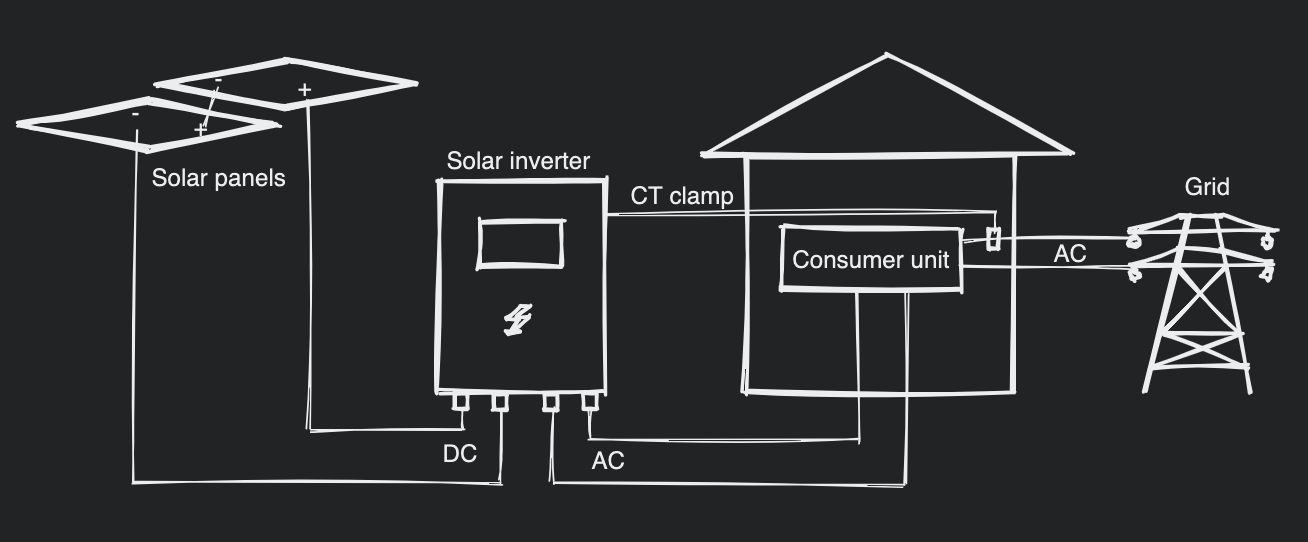
In a grid-tied system, the solar inverter is connected to the solar panels, to battery storage if available and to your home. The inverter performs multiple measurements and adjustments to orchestrate the energy allocation between consumers, such as your home and suppliers, typically solar panels and batteries. The battery can be a consumer and a supplier at different times, making the logic the inverter needs to handle increasingly complex.
The inverter aims to match your home’s electricity consumption. If the inverter cannot provide the necessary power from its energy suppliers, it will give as much as it has available, and your home will draw the rest from the grid. If you only want to supply your home, the inverter can be configured to halt the production of AC when no energy is consumed in your home.
Inverters can be configured to export excess power to the grid or store it in the battery. On most inverters, you can prioritise energy allocation to distribute energy to the most valuable location first. For example, charge the battery first and only then export.
How is the Solar Inverter Connected to Your Home?
Solar inverters have AC ports that connect to your home. The safe and sensible way to do this is by connecting the inverter to a consumer unit.
Inverter producers recommend that solar inverters be connected to a dedicated circuit in your consumer unit. You should have the circuit installed in advance or when connecting the inverter.
Building Regulations Notifiable Work In the UK
If you are in the UK, please note that adding a circuit is subject to building regulations, and you may need to hire a competent person with the correct certification and insurance to perform that work. The good news is that this is a common electrician service, and there is no need for solar specialists to do it.
Inverter Safety and Placement: UK Standards
Following PAS 63100 guidance, avoid installing inverters in bedrooms, lofts prone to overheating, or escape routes. The best locations are:
- Garage – Well ventilated, easy access
- Utility room – Protected from weather
- Outbuilding – With proper ventilation
Most inverters come with 10-12 year warranties, with premium models offering up to 20-25 years. This matters because panels last 25+ years, so you’ll likely need one inverter replacement during your system’s lifetime.
Inverter Costs and Lifespan: UK 2025
Here’s what you can expect to pay for inverters in the UK in 2025:
- String inverter: £500–£1,000
- Microinverters: £120–£180 per panel (e.g., ~£2,000 for a 12-panel system)
- Hybrid inverter: £1,200–£2,500+
Lifespan: Expect 10-15 years from most inverters. Since panels last 25+ years, budget for one replacement during your system’s lifetime.
Smart tariff benefits: Hybrid inverters let you buy cheap overnight electricity and use it during peak times. With tariffs like Octopus Energy’s Agile, you can save significantly by timing your energy use. Learn more about battery storage without solar and how it can work with flexible tariffs.

The price of this service ranges from £250 in common cases to unknown values based on how far away is your shed or garage and other complications such as physical obstructions around the inverter or the distance to it.
Advanced Circuit Breaker is Recommended
A slight peculiarity of these circuits is that it is recommended to use type C RCBO. Some electricians, who have not had to connect an inverter before may consider the type C RCBO an overkill but this is what inverter producers recommend, and you should insist on it.
How do We Ensure We Use Energy From Solar Panels and not From the Grid?
Are additional components, such as intelligent switches, required? The answer is no. Electrical devices in your home consume electricity supplied by your inverter with priority. This is because when a load (such as a light or appliance) is switched on, it will draw power from the most readily available source. In a grid-tied domestic solar system, that source is the solar inverter. As shown in the diagram above, the inverter is connected after the grid entry point in your home. This makes it closer than any powerplant generating electricity delivered through the grid.
How Does the Inverter Know if Energy is Consumed in Your Home?
Solar inverters use information obtained either by a generation meter or a current transformer (CT) clamp connected to the grid entry point of your home. The systems inside the solar inverter take split-second measures and make prompt adjustments to provide the required energy to match your home’s consumption and allocate excess energy based on your configuration.
Frequently Asked Questions
Do I need a solar inverter if I only want panels?
Yes, absolutely. Solar panels produce DC electricity, but your home needs AC. Without an inverter, your panels would be useless—it’s like having a car with no engine.
Can solar panels work without an inverter?
No. Solar panels produce DC electricity that’s incompatible with your home’s electrical system. The inverter is essential for converting this energy into usable AC power.
How long do solar inverters last?
Most inverters last 10-15 years, while solar panels last 25+ years. Budget for one inverter replacement during your system’s lifetime. Premium models can last 20-25 years.
What’s the best inverter for a shaded roof?
Microinverters or optimizers work best for shaded roofs. Each panel operates independently, so shading on one panel doesn’t affect the others. String inverters perform poorly with shading.
What happens if my inverter fails?
Your solar system stops producing usable electricity. You’ll need to replace the inverter, but your panels and other components remain unaffected. Most inverters come with 10-12 year warranties.
Can my inverter power my house in a blackout?
Standard grid-tied inverters shut down during blackouts for safety. Only hybrid inverters with battery storage can provide backup power during outages.
How much do solar inverters cost in the UK in 2025?
String inverters cost £500-£1,000, microinverters £120-£180 per panel, and hybrid inverters £1,200-£2,500+. The total depends on your system size and requirements.
Conclusion
Choosing the right solar inverter is one of the most important decisions you’ll make for your solar system. It’s the brain that makes everything work together—converting solar energy into usable electricity, managing battery storage, and optimising your energy use.
Whether you’re planning a simple string inverter for an unshaded roof or a hybrid system for maximum flexibility, understanding how inverters work helps you make informed decisions that will pay off for decades. For more guidance on choosing the right inverter for your specific situation, check out our complete inverter selection guide.
Ready to Start Your Solar Journey?
Want step-by-step help on your solar journey? Subscribe to our newsletter for homeowner-friendly solar guides, real-world installation stories, and practical tips to maximise your solar investment.

